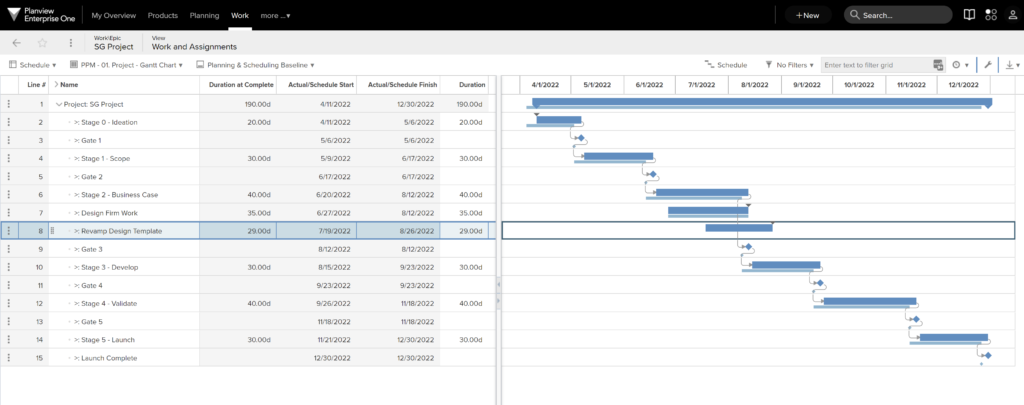The right focus, the right results PMOs must be business focused; you have probably heard that,…

Turn the Tables on Product Development Disruptions

Disruptions to effective product development are constant but don’t need to be detrimental to an organization’s ability to deliver innovation with speed and maintain a healthy ROI. Suppose organizations make adaptability a cornerstone of their product development strategy and overall culture. That shift creates constant momentum, making it easier to adjust perspectives and see with more clarity all the opportunities to turn the tables on disruption.
Organizations can mature their approach to product portfolio management by embracing change as an opportunity. As a byproduct of that growth, they will find it easier to:
- Unearth strategic innovation
- Differentiate at speed
- Gain a competitive advantage
The Constant and Evolving State of Disruption
Barriers to effective product development have always existed; they are not new. But as the world becomes more connected and technologies become more advanced, disruptive elements that may have concentrated on a specific region or industry have developed a far greater reach.
In addition to workforce challenges, analysts have identified three of the most impactful ongoing disruptions to product development that organizations face:
- Consumer Demand for Smart Connected Products – This is felt most strongly in the MedTech industry, where organizations must balance consumer demand with regulatory compliance and a heightened need for security.
According to Deloitte, 68% of all medical devices produced over the next five years will be IoT devices. MedTech companies cannot afford to be late or slow adapting if they want to remain competitive.
- Drive Toward Digitally Enhanced Product Experiences – Similar to the companies that produce medical devices, organizations that create physical products are experiencing increased pressure to supplement those products with some form of digitization.
Whether it is household items that can be controlled from a mobile phone or product packaging that offers an augmented digital experience, the demand for digitally enhanced products is only growing. By 2025, 80% of the Top 100 global CPG (consumer packaged goods) companies plan to make digital experiences part of their physical products, according to Gartner.
- Impacts of Supply Chain and ESG (Environmental, Social, Governance) – Lastly, arguably the most prevalent in recent times, is realizing how genuinely delicate a global supply chain is. Supply chain disruptions will most likely increase, coupled with the drive to be more environmentally responsible.
Recent disruptive events have made it evident that addressing supply chain frailty and sustainability challenges must be overarching strategic objectives for organizations across multiple industries. Business leaders worldwide reported a 100% increase in labeling ESG and sustainability initiatives as 2022 business priorities.
The good news is that overcoming these disruptions is possible. Even better, beyond the possibilities, there is opportunity.
Responding to these disruptions by maturing and adapting product portfolio management processes to prioritize intelligent innovation will help organizations overcome these disruptions and pave the way to becoming market leaders—disruptors themselves.
Four Keys to Mature Your Product Portfolio Management Process
Flexibility and adaptability are the hallmarks of a mature and modernized product portfolio management process. Creating these capabilities requires organizations to adopt a product portfolio management platform that seamlessly aligns people, processes, and technology.
There are four critical factors a product portfolio solution must prioritize to help build and support that alignment. It must:
- Support optimization of ideas
- Maximize value
- Clarify resource allocation
- Empower collaboration
Optimize product prioritization with data-driven innovation
The next great idea or innovation can come from anywhere—employees, partners, third parties, and even customers. The ability to capture and store new ideas (which can often emerge out of disruptions) from various sources in a centralized location is essential.
The next great idea or innovation can come from anywhere—employees, partners, third parties, and even customers.
By providing an “ideation hub,” organizations can gain a global view of product potential, including knowledge from a wealth of resources and a wide diversity of voices. Furthermore, with a layer of applied machine learning, such a hub could also build visualizations to organize ideas in ways that provide deeper intelligence, allowing a company to identify themes faster and speed smarter innovation.
Maximize product portfolio value
Once we identify and prioritize opportunities and innovations, we must match them to a value stream that begins and ends with the customer in mind. The question we need to answer in this stage is: Where does that new idea fit in the larger scheme of a product portfolio?
Smartly applying value to a product—for both organization and customers—helps mitigate many product development biases that are part of planning complex R&D portfolios. All too often, risk is only attributed to things inside the development of a product. A solution that offers visibility into multiple dimensions of risk and disruption—like commercial and regulatory risks—clarifies prioritization and elevates decision-making into a more comprehensive layer of product development. In this sense, what needs to take place to obtain the maximum value from product to product becomes readily apparent.
Pivot resources and investments
With established value, we can now consider resource investments and funding. This is where the ability to formulate scenario planning—answering “what if” questions—becomes invaluable.
For example, what if, amid development, a specific resource is limited or unavailable due to an unexpected disruption? If resources and investments are initially aligned to prioritized work, we lessen or mitigate unexpected setbacks.
Planning upfront is essential, but preparedness continues beyond this point.
Constant insight into what is happening with projects in progress and all their dependencies can decrease the impact of disruption, enable quick and fluid adaptation, and help avoid costly mistakes and bottlenecks.
Accelerate cycle times and enable cross-collaboration
The foresight that comes with ongoing analysis can lessen the effect of disruption and reinforce delivery management processes. Enable cross-functional teams to understand and communicate the impact of disruption. Improving their ability to collaborate and adjust product roadmaps accordingly is central to optimizing an ongoing product portfolio management and the delivery process.
Imagine a Gantt chart with multiple layers of information corresponding to key milestones at the most critical levels, from activity to project to portfolio—anywhere potential risks could surface. Now imagine being able to filter and drill down through those metrics to understand where risks originate and communicate that information across the organization.

With this level of insight, disruptions to product development wouldn’t stand a chance.
Adaptation is Crucial to Successful Product Development
Gaining an edge on the competition and enacting your own market disruptions through innovations that exceed customer demands requires adaptivity; it must be infused into an organization’s culture and every stage of product portfolio management. When adaptivity is a cornerstone of your product development framework, you can:
- Provide visibility across product lines
- Ensure products align with organizational strategies
- Improve teamwork and cross-functional collaboration
- Decrease cycle time and speed products to market
Getting Started with an Adaptive Approach to Product Development
In the webinar “How to Overcome Disruptions to Effective Product Development,” we examine lessons learned by global product companies representing a range of industries. Each organization was able to apply the above four keys to maturing its product portfolio management process, revealing its own opportunities to:
- Gain foresight and visibility into opportunities
- Adapt to change by optimizing resources and product investments
- Mitigate the effect of disruptions and move forward with confidence
To get the full story of how these companies were able to turn the tables on product development disruptions, watch the entire webinar now!
Source link



This Post Has 0 Comments